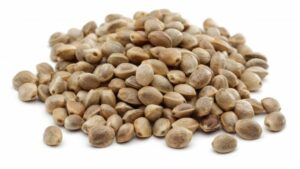Two resolutions to come out of the Canadian Seed Growers’ Association annual meeting serve to take the pedigreed seed industry into new territory.
_x000D_
The Canadian Seed Growers’ Association emerged from its annual meeting in Clear Lake, Man., in July with two resolutions that could serve to change the Canadian seed landscape in some pretty significant ways._x000D_
_x000D_
CSGA resolved to update its Circular 6 document, which contains the requirements to produce pedigreed seed crops in Canada, to be more in line with modern technology and the present-day regulatory environment. The decision could see major updates made to a document that was originally written in the 20th century._x000D_
_x000D_
At the same time, CSGA passed a resolution — looking ahead to 2017 and the federal government’s plans to legalize marijuana — to develop standards by which all varieties of cannabis can be certified. In passing the resolution, CSGA has begun a conversation that Canada’s seed industry has yet to formally discuss around a boardroom table._x000D_
_x000D_
Pedigreed Seed in the 21st Century_x000D_
_x000D_
If Canadian pedigreed seed growers have their own Bible, Circular 6 is it. Its full name, Canadian Regulations and Procedures for Pedigreed Seed Crop Production, couldn’t be any more literal. The lengthy document details how pedigreed seed crops must be grown in Canada. Growers wishing to produce pedigreed seed must understand these requirements and plan their operations to comply with them._x000D_
_x000D_
Circular 6 has a history that’s as long and detailed as the document itself — an early version dates back to 1929 and deals only with self-fertilizing grain crops._x000D_
_x000D_
“It was created decades ago, but it’s not like it hasn’t changed,” says Michael Scheffel, CSGA managing director, policy and standards. “It has been revised on an annual basis in response to things that come up._x000D_
_x000D_
“It’s done a good job of being up-to-date on things, but we haven’t stepped back and said, ‘Let’s take a more holistic look at it.’”_x000D_
_x000D_
Saskatchewan Seed Growers’ Association president Roy Klym has felt for years that Circular 6 needs to be updated to reflect the modern regulatory environment and modern technology. He was at the CSGA meeting and seconded the motion to pass the resolution._x000D_
_x000D_
“As with everything else, as times have evolved, technology has changed,” Klym says. “We no longer drive our tractors the way we used to. Satellites run them today. Seed processing is the same — it’s changing and evolving and we have to keep up with the technology.”_x000D_
_x000D_
He feels Circular 6 is behind the times, especially considering that modern technology can solve many of the problems Circular 6 set out to fix with a number of requirements for pedigreed field crop inspection._x000D_
_x000D_
“Circular 6 talks a lot about purity, and there was a problem with that years ago, partly due to the limitations of cleaning facilities,” Klym says. “I can very readily clean green peas out of yellow peas. Ten years ago, not possible. Does that mean you will decline a field of yellow peas because you’re above the purity level on the greens? Secondary processing can remove that.”_x000D_
_x000D_
There are numerous other examples Klym points to that he says make now the time to update Circular 6 to better reflect what modern technology can do. As president of the Saskatchewan Seed Growers’ Association, he sees a lot of growers who would benefit from a more modern Circular 6 — especially considering the document is only available in print and online in a cumbersome PDF form._x000D_
_x000D_
At a time when farmers and seed crop inspectors are doing their work on tablets, laptops and other devices, Klym says the document needs to be accessible quickly and easily on all devices._x000D_
_x000D_
“Part of the impetus for this comes from the fact that seed crop inspection was privatized a couple of years ago with Alternative Service Delivery. Seed growers are paying 100 per cent of the cost of a field inspection now,” Scheffel adds._x000D_
_x000D_
Part of the resolution, Scheffel notes, is to also look at simplifying the language in Circular 6. When standards and procedures are complicated and hard to understand, and farmers don’t get their crops certified because of a misunderstanding — or it takes the inspector an extra half-hour in the field to complete an inspection report — it all ends up costing time and money._x000D_
_x000D_
“We’re looking to simplify it in some ways in regards to standards and procedures, but also in the way the information is presented. Eventually we’d like to go to an electronic document that has hyper-links and makes use of the digital format to create an easier to use, easier to look at, better document, overall,” Scheffel says._x000D_
_x000D_
Klym hopes the changes will be implemented for 2017, but Scheffel adds those changes will have to be made carefully to ensure standards are maintained._x000D_
_x000D_
“We need to go through a proper process and make sure our standards committee has a good discussion on what’s being proposed and what some of the unintended consequences could be,” Scheffel says. “We’re going to be looking at a multi-phase approach.”_x000D_
_x000D_

_x000D_
Beginning the Cannabis Discussion_x000D_
_x000D_
Reuben Stone grows hemp seed in Renfrew County, Ont., as the owner of Stone Farms. He was at the CSGA meeting in July, and was successful in having a motion passed that could be one of the most significant in recent history, if it comes to fruition._x000D_
_x000D_
Stone proposed a resolution that CSGA create standards by which all cannabis can be certified. Currently, CSGA only has standards for industrial hemp._x000D_
_x000D_
The Liberal government has announced that it plans to legalize marijuana in 2017. Although nothing has been announced in terms of what exactly that will look like, Stone says there will be opportunities for the seed industry on the horizon, and CSGA needs to be a leader in what he says will be an important industry._x000D_
_x000D_
“There’s going to be more potential for harvesting for different products other than just grain and fibre, and we’ll need different germplasm to capitalize on that,” Stone says. “Cannabinoid production in industrial hemp is a big opportunity, and that will require some different mechanisms.”_x000D_
_x000D_
Scheffel says the resolution spearheaded by Stone wasn’t a surprise to CSGA staff, as the issue has been talked about for some time now._x000D_
_x000D_
“We’ve been talking in the office about our potential role when it comes to the legalization of marijuana and what we might be able to do in that area when it comes to tracking and traceability,” he says._x000D_
_x000D_
Scheffel doesn’t foresee marijuana seed production happening in the field. If and when the federal government legalizes high-THC cannabis, he says CSGA’s role could potentially be in the tracking of seed lots._x000D_
_x000D_
CSGA is currently not involved in the medical marijuana industry, but Stone says that could change, in his opinion. He explains that a major crossover between the industrial hemp and medical cannabis industries is on the horizon if and when marijuana is legalized in 2017. He notes that not all medical cannabis is necessarily high in tetrahydrocannabinol, or THC, the active ingredient in marijuana that causes psychoactive effects._x000D_
_x000D_
“There are other compounds in the plant that are important,” he says. “The medical marijuana industry has the same issues hemp seed growers deal with as far as seed goes — plant breeders rights, transfer of seed stock, that kind of thing. All of that is important to them, but they don’t have the mechanisms to take action right now. CSGA could play an important role in that. It’s not just about fibre anymore.”_x000D_
_x000D_
But there are still a lot of unknowns, Scheffel notes. “Until we know what the regulatory regime looks like, we’re not totally sure if there’s a role here for CSGA,” he says._x000D_
_x000D_
For 32-year-old Stone, it’s about Canadian seed growers being able to get in on the ground floor and capitalize on opportunities they might miss if the industry isn’t prepared._x000D_
_x000D_
“At Stone Farms, we got into seed because of hemp — that’s where a lot of our opportunities have manifested. If I came up with a breeding program for soybeans, I’d be up against some strong competition. Hemp has allowed us to really participate in the seed industry,” he says._x000D_
_x000D_
“We need to talk about this and be ready. When we start to look at these other opportunities, if Canada doesn’t get its act together around this, we’ll lose our leadership position. There’s a lot of other countries that will surpass us in a hurry.”













